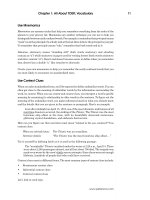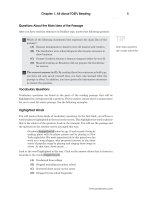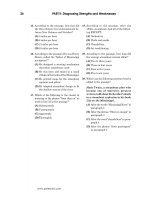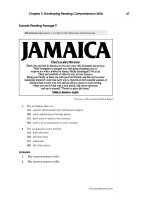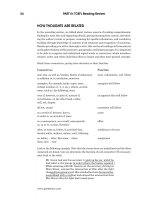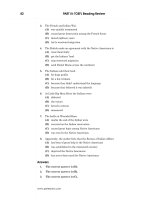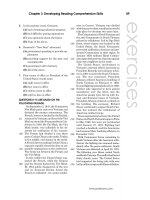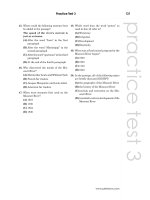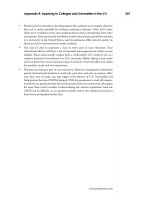Peterson’s master toefl vocabulary part 3 pps
Bạn đang xem bản rút gọn của tài liệu. Xem và tải ngay bản đầy đủ của tài liệu tại đây (67.98 KB, 7 trang )
Chapter 1: All About TOEFL Vocabulary 5
www.petersons.com
• The words explained in terms that you can understand.
• A size that fits your needs. You might wish to buy a hardbound dictionary to use
at home when you study and a smaller paperback to keep in your backpack or
briefcase for immediate reference.
• An online dictionary can’t fulfill all your needs, unless you like to tote around your
laptop and fire it up all the time. Always have a print dictionary to use, even if you
have an online version.
When you’re trying to find a word in the dictionary, always begin by making an educated
guess as to its spelling. The odds are in your favor. However, the more spelling patterns
you know for a sound, the better your chances of finding the word quickly. You can find
a pronunciation chart in the beginning of any dictionary. Once you’ve narrowed down
your search and you’re flipping through the pages, use the guide words, located on the
upper-corners of the pages, to guide your search. Then, follow strict alphabetical order.
The following diagram shows how to read a sample entry.
can-dy (kan’de), n. pl. -dies, v., -died, -dying. —n. 1. any
of a variety of confections made with sugar, syrup, etc.
combined with other ingredients. 2. a single piece of such a
confection. —vt: 3. to cook in sugar or syrup, as sweet
potatoes or carrots. 4. to cook in heavy syrup until transpar-
ent, as fruit, fruit peel, or ginger. 5. to reduce (sugar, syrup,
etc.) to a crystalline form, usually by boiling down. vi: to
become candied. see vt. [ME sugre candy candied sugar
< MF sucre candi; candi << Ar qandi or sugar = qand sugar
(< Pers; perh. orig. piece of sugar candy; if so, akin to Skt
khanda piece)]
Let’s look a little closer at the entry:
• Notice the pronunciation comes right after the entry word. It’s in parentheses—
(kan’de).
• The part of speech is indicated by the n. It’s an abbreviation for “noun.” Look at the
third entry. The vt: right before the 3. shows that the word can be used as a
transitive verb (a verb that must be followed by a direct object). The vi: at the end
of the fifth entry shows that the word can also be used as an intransitive verb (a verb
that does not need a direct object to make sense in a sentence).
• The pl. at the beginning of the entry shows how you can make the word plural (more
than one). Here, the singular “candy” becomes the plural “candies.”
spelling,
pronunciation
part of speech
plural
definitions
etymology
(word history)
01_TOEFL Vocab,Ch1,1-18 8/4/06, 12:285
6PART I: TOEFL Vocabulary Basics
www.petersons.com
• The definitions follow the plural forms of the word. The word “candy” has several
different meanings. They are arranged by the part of speech: the first definitions
show what “candy” means when used as a noun; the second group shows what
“candy” means when used as a verb.
• The information at the very end of the entry is the etymology or history of the word.
This shows how the word was formed and came into English.
A thesaurus is a reference book that contains synonyms and antonyms. The word
thesaurus comes from a Greek word that means “collection” or “treasure.” A thesaurus
is especially helpful when you’re trying to express an idea but you don’t know how to
phrase it. It is also a helpful reference book when you are trying to find a better word
than the one you’ve been using. This helps you state exact shades of meaning rather
than approximations. As a result, your vocabulary increases by heaps and heaps of
words. This is clearly a big advantage when it comes to preparing for a standardized
test.
In a thesaurus, words with similar meanings are grouped together. To find a synonym
for a word in a traditional print thesaurus, you must use the index at the back of the
book. However, new editions and online versions of a thesaurus are arranged like a
dictionary in alphabetical order.
If you look up the word exciting in a print thesaurus, you would find this entry:
excitement [n] enthusiasm; incitement
action, activity, ado, adventure, agitation, animation, bother,
buzz*, commotion, confusion, discomposure, disturbance, dither*,
drama, elation, emotion, excitation, feeling, ferment, fever, flurry,
frenzy, furor, fuss, heat*, hubbub*, hullabaloo, hurry, hysteria,
impulse, instigation, intoxication, kicks*, melodrama, motiva-
tion, motive, movement, passion, perturbation, provocation, rage,
stimulation, stimulus, stir, thrill, titillation, to-do, trepidation,
tumult, turmoil, urge, warmth, wildness. SEE CONCEPTS 38,
410, 633.
SEE CONCEPTS in the print thesaurus takes you to the Concept Index, which helps you
link different related ideas. In this way, you can find the exact shade of meaning you
need. Use the key in the beginning of the print thesaurus to understand different
symbols. In this entry, for example, the * shows that a word is colloquial or the slang
level of usage.
Online thesaurus programs are especially useful for distinguishing among homonyms.
If you intended to type “whether” but instead keyboarded “weather,” the thesaurus will
give you synonyms like atmospheric conditions, climate, meteorology, and the elements.
This can help you keep your homonyms straight.
01_TOEFL Vocab,Ch1,1-18 8/4/06, 12:286
Chapter 1: All About TOEFL Vocabulary 7
www.petersons.com
While both a print and an online thesaurus unquestionably will help you beef up your
vocabulary, in general, a print thesaurus will give you more options than an online
thesaurus. That’s because the print versions have more words in them. Therefore, you’ll
need a print thesaurus even if you have an online version. Use a print thesaurus when
you need a wider variety of choices.
Pronounce Words Correctly
Knowing the meaning of a word is only half the battle; you also have to know how to
pronounce it. It’s astonishing how many words are misunderstood simply because they
are mispronounced. Words get mangled in surprisingly inventive ways. For example,
people often switch letters. For example, abhor (hate) becomes uh-bor rather than ab-hor.
People have also been known to drop letters. For instance, the food poisoning known as
salmonella is correctly pronounced sal-muh-nel-uh. Dropping the L results in sam-uh-
nel-uh.
The pronunciation problem is especially acute with words that can function as more
than one part of speech. The word ally is a case in point. As a noun, it’s pronounced al-
eye. As a verb, it’s pronounced uh-lie.
In addition, people often insert an extra letter or two, which can make the word
unrecognizable. For instance, ambidextrous (able to use either hand) has four syllables
and is correctly pronounced am-bi-deks-trus. But sometimes speakers add an extra
syllable to get am-bi-deks-tree-us or am-bi-deks-tru-us.
Even the lowly word picture can get warped as pitcher. As a result, no one knows what
anyone else is talking about. Incorrect pronunciations can make it impossible to define
the word, too.
The most effective way to learn how to pronounce new words is by using a dictionary.
Get a reliable desk or pocket dictionary. It’s the best source for the words you need to
get you where you want to go.
How well do you pronounce testworthy words? Take the following self-test to see. Cover
the third column with a piece of paper. Then read each word and its definition.
Pronounce each word. Last, check the third column to see how well you did.
01_TOEFL Vocab,Ch1,1-18 8/4/06, 12:287
8PART I: TOEFL Vocabulary Basics
www.petersons.com
Word Meaning Pronunciation
Amish Pennsylvania Dutch ah-mish
aplomb assurance uh-plahm
awry wrong, crooked uh-ry
banquet feast bang-kwit
buffet self-service meal buh-fay
buoy floating marker boo-ee
Celtic Irish kel-tik
denouement conclusion day-noo-mah
entrepreneur business person ahn-truh-pruh-nur
fracas noisy fight fray-kis
hegemony leadership hi-jem-uh-nee
insouciant carefree in-soo-see-int
khaki light brown kak-ee
larynx voice box lar-ingks
mausoleum tomb maw-suh-lee-um
niche corner nich (rhymes with “itch”)
penchant inclination pen-chint
posthumous after death pahs-chuu-mus
quagmire swamp kwag-myr
remuneration payment ri-myoo-nuh-ray-shin
shallot onion shal-it or shuh-laht
toupee hairpiece too-pay
vehement fiery, passionate vee-uh-mint
verbiage wordy vur-bee-ij
worsted yarn wuus-tid
Use Word Cards
One of the most effective ways to make a word your own is through repetition. Going over
the word can help you master its meaning as well as pronunciation and usage. Try this
idea: buy a stack of 3 × 5 index cards.
As you read through the following chapters, write each difficult word on the front of an
index card, one word per card. Then, write the definition on the back. Here’s a sample:
01_TOEFL Vocab,Ch1,1-18 8/4/06, 12:288
Chapter 1: All About TOEFL Vocabulary 9
www.petersons.com
FRONT:
matriarch
BACK:
the female head of
a family or tribe
Learn Synonyms and Antonyms
Synonyms are words that are nearly the same in meaning as other words. Antonyms are
words that are opposites. Learning different synonyms and antonyms can help you
swell your vocabulary. Go ahead and try it now.
Complete the following chart by writing at least one synonym and antonym for each
word. Then, see how many more synonyms and antonyms you can brainstorm. Possible
answers follow.
Word Synonym Antonym
1. adapt _________________________ _________________________
2. authentic _________________________ _________________________
3. chronic _________________________ _________________________
4. conquer _________________________ _________________________
5. frustrate _________________________ _________________________
6. indulge _________________________ _________________________
7. naïve _________________________ _________________________
8. punish _________________________ _________________________
9. relinquish _________________________ _________________________
10. sullen _________________________ _________________________
01_TOEFL Vocab,Ch1,1-18 8/4/06, 12:289
10 PART I: TOEFL Vocabulary Basics
www.petersons.com
Suggested answers:
Word Synonyms Antonyms
1. adapt adjust, accustom, accommodate disarrange, dislocate
2. authentic genuine, real, legitimate fake, counterfeit, bogus,
imitation
3. chronic habitual, ongoing, constant one time, single
4. conquer defeat, vanquish, overwhelm surrender, yield, forfeit, give up
5. frustrate baffle, beat, disappoint facilitate, encourage
6. indulge tolerate, humor, allow, permit prohibit, deter, restrain, enjoin
7. naïve innocent, ingenuous worldly, urbane, suave
8. punish discipline, castigate reward, compensate,
remunerate
9. relinquish quit, renounce perpetuate, keep
10. sullen irritable, morose, moody cheerful, jolly, blithe, happy
Understand a Word’s Unstated Meanings
Every word has a denotation, its dictionary meaning. In addition, some words have
connotations, their understood meanings or emotional overtones. For example, both
house and home have the same denotation, a shelter. Home, however, carries a
connotation of warmtl!and love not present in house.
Use Word Parts
A surprisingly large number of words can be divided into parts that you can figure out
easily. If you can define the parts, then you can often decode the entire word. This is a
crucial skill on standardized tests, when you’re under time constraints.
There are three main word parts to know: roots, prefixes, and suffixes.
• A root is a base or stem form of many words. Roots are covered in depth in Chapter 5.
• A prefix is a letter or a group of letters placed at the beginning of a word to change
its meaning. Prefixes are covered in depth in Chapter 6.
• A suffix is a letter or a group of letters placed at the end of a word to change its
meaning. Suffixes are covered in depth in Chapter 7.
For example, if you know the Latin root ami means “like” or “love,” you can easily figure
out that amiable means “pleasant and friendly.” Similarly, you could deduce that
amorous means “loving.” Even if you can’t define a word exactly, recognizing the
different parts of the word still will give you a general idea of the word’s meaning.
01_TOEFL Vocab,Ch1,1-18 8/4/06, 12:2810
Chapter 1: All About TOEFL Vocabulary 11
www.petersons.com
Use Mnemonics
Mnemonics are memory tricks that help you remember everything from the order of the
planets to your grocery list. Mnemonics are another technique you can use to help you
distinguish between easily confused words. For example, to remember that principal means
“main” (as in the principal of a school), look at the last three letters: the principal is your pal.
To remember that principle means “rule,” remember that both words end in le.
Likewise, stationary means “standing still” (both words stationary and standing
contain an “a”) while stationery is paper used for writing letters (both words stationery
and letter contain “er”). Desert and dessert become easier to define when you remember
that dessert has a double “s,” like strawberry shortcake.
Create your own mnemonics to help you remember the easily confused words that you
are most likely to encounter on standardized tests.
Use Context Clues
When you take standardized tests, you’ll be expected to define unfamiliar words. You can
often get clues to the meaning of unfamiliar words by the information surrounding the
word, its context. When you use context and context clues, you interpret a word’s specific
meaning by examining its relationship to other words in the sentence. To figure out the
meaning of the unfamiliar word, you make inferences based on what you already know
and the details that you are given in the sentence or paragraph. Here’s an example:
Just after midnight on April 15, 1912, one of the most dramatic and famous of all
maritime disasters occurred, the sinking of the Titanic. The Titanic was the most
luxurious ship afloat at the time, with its beautifully decorated staterooms,
glittering crystal chandeliers, and elaborate food service.
How can you figure out that maritime must mean “related to the sea, nautical”? Use
context clues:
What you already know The Titanic was an oceanliner.
Sentence details “The Titanic was the most luxurious ship afloat. . .”
Try it yourself by defining futile as it is used in the following passage:
The “unsinkable” Titanic vanished under the water at 2:20 a.m., April 15. There
were about 2,200 passengers aboard, and all but about 700 died. The tragedy was
made even worse by the crew’s futile rescue attempts. Since there were not enough
lifeboats, hundreds of people died who could have survived.
Context clues come in different forms. The most common types of context clues include:
• Restatement context clues
• Inferential context clues
• Contrast context clues
Let’s look at each type.
01_TOEFL Vocab,Ch1,1-18 8/4/06, 12:2811
